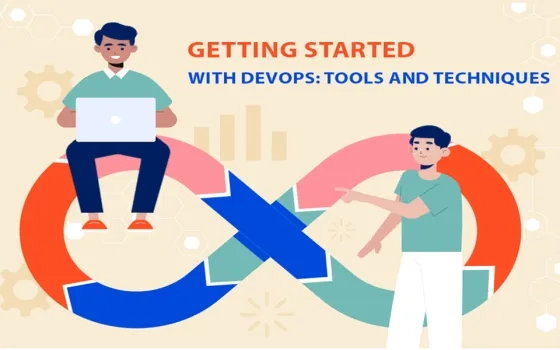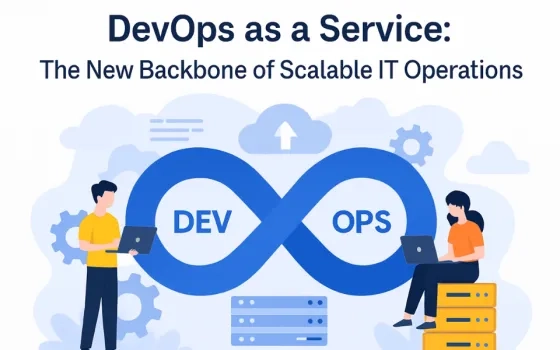The term “DevOps” has become more than just a buzzword—it’s a transformative approach that bridges the gap between development and operations. Imagine a world where software is released at lightning speed without sacrificing quality or stability; that’s the power of DevOps! Whether you’re an experienced developer looking to streamline your workflow or a business leader eager to enhance collaboration across teams, understanding the right tools and techniques can unlock tremendous potential for your organization. In this blog post, we’ll dive into what makes DevOps tick, explore essential tools that empower teams to work smarter—not harder—and share practical techniques that will set you on the path toward seamless integration and continuous delivery. Let’s embark on this journey together as we demystify DevOps and equip you with everything you need to kickstart your transformation!
Introduction to DevOps
DevOps is more than just a buzzword in the tech world—it’s a transformative approach that combines development and operations to create seamless workflows. In an era where speed and efficiency are paramount, organizations are increasingly turning to DevOps practices to bridge gaps between teams, enhance collaboration, and deliver high-quality software faster.
But what exactly does it entail? From integrating various tools to adopting innovative techniques, getting started with DevOps can seem overwhelming. However, understanding its core principles can lead you on a journey toward streamlined processes and improved productivity. Whether you’re part of a small startup or a large enterprise, embracing these methodologies can revolutionize how your team operates.
Curious about how to implement this game-changing philosophy? Let’s dive into the essential tools and techniques that will set you on the right path!
Benefits of Implementing DevOps
1. Increased Collaboration and Communication:
One of the major benefits of implementing DevOps is the increased collaboration and communication between different teams involved in the software development process. The traditional siloed approach often leads to miscommunication, delays, and errors. With DevOps, developers, testers, and operations teams work together throughout the entire development lifecycle. This streamlines communication and promotes a culture of collaboration, leading to faster delivery of high-quality software.
2. Faster Time to Market:
DevOps emphasizes on automation and continuous integration/continuous delivery (CI/CD) practices which allow for faster deployment of new features and updates. By automating routine tasks such as testing, building, and deploying code changes, developers can focus on developing new features rather than spending time on manual tasks. This results in quicker release cycles and enables companies to bring their products or services to market faster.
3. Improved Quality:
By integrating automated testing into the development process through CI/CD pipelines, DevOps ensures that any issues are identified early on in the development cycle. This helps in preventing bugs from making it into production which ultimately improves the overall quality of the product or service being delivered.
4. Reduced Risk:
With traditional methods, a small change made by one team can have unintended consequences leading to failures in production. However, with DevOps practices like automated testing and continuous monitoring in place, these risks are greatly reduced as issues are identified earlier and can be fixed before they affect end-users.
5. Cost Savings:
Implementing DevOps practices can lead to cost savings for organizations by reducing manual labor costs associated with repetitive tasks such as provisioning servers or managing infrastructure configuration changes manually. Additionally, by identifying issues early on in the development process through automation and continuous monitoring processes, companies can save money that would have been spent on fixing these issues later during production.
6. Scalability:
DevOps also allows for better scalability as it enables organizations to quickly adapt to changing business needs and market demands. By automating infrastructure provisioning, DevOps allows for quick scaling up or down of resources based on the current demand. This ensures that companies can efficiently handle spikes in traffic without any disruptions or downtime.
Implementing DevOps brings a multitude of benefits to organizations looking to streamline their software development processes. From improved collaboration and communication to faster time to market and cost savings, DevOps is a valuable approach that promotes efficiency, quality, and collaboration within teams.
Key Principles of DevOps
At the heart of DevOps lie several key principles that drive its success. Collaboration stands out as a fundamental aspect, encouraging communication between development and operations teams. This synergy fosters shared goals and a more cohesive work environment.
Another principle is automation. By automating repetitive tasks, organizations can reduce human error and increase efficiency. Automation tools streamline processes from coding to deployment.
Continuous feedback is also crucial in the DevOps landscape. It enables teams to gather insights quickly and make informed decisions based on real-time data. This adaptability enhances product quality over time.
Lastly, embracing a culture of experimentation encourages innovation within teams. With a focus on learning rather than fearing failure, companies can explore new ideas without hesitation, ultimately leading to better solutions for users.
Common Tools and Technologies Used in DevOps
DevOps is a methodology that combines development (Dev) and operations (Ops) teams to work together in order to deliver high-quality software products efficiently. This approach requires seamless collaboration and communication between these two departments, which can be achieved with the help of various tools and technologies. In this section, we will discuss the common tools and technologies used in DevOps.
1. Version Control Systems:
Version control systems such as Git, SVN, or Mercurial are widely used in DevOps for source code management. These tools allow developers to track changes made to the codebase, collaborate with team members on different versions of the code, and revert back to previous versions if necessary. They also provide features like branching and merging, which are essential for managing multiple releases simultaneously.
2. Continuous Integration/Continuous Delivery (CI/CD) Tools:
CI/CD tools automate the process of building, testing, and deploying software changes consistently and quickly. Popular CI/CD tools like Jenkins, Travis CI, or CircleCI integrate with version control systems to automatically trigger builds whenever there is a new commit in the repository. These tools enable teams to catch bugs early on in the development cycle and ensure that every release is thoroughly tested before deployment.
3. Configuration Management Tools:
Configuration management tools like Puppet, Chef, or Ansible help automate infrastructure provisioning by managing configurations across different environments consistently. They use a declarative approach where developers define how they want their infrastructure to look like instead of manually configuring each server separately. This saves time and reduces human error while ensuring consistency across all environments.
4. Infrastructure as Code (IaC):
IaC refers to writing scripts or templates that describe infrastructure components such as servers, databases, networks in a reusable format using languages like YAML or JSON. IaC enables teams to treat infrastructure as code; hence it can be version controlled along with application code leading to better collaboration between DevOps teams.
5. Monitoring and Logging Tools:
Monitoring and logging tools are crucial in DevOps for tracking application performance, detecting issues, and troubleshooting errors. Popular tools like Prometheus, ELK stack (Elasticsearch, Logstash, Kibana), or New Relic allow teams to gather real-time metrics and logs from different sources, analyze them, and take proactive measures to prevent potential failures.
The above-mentioned tools and technologies are essential in implementing DevOps practices successfully. However, it is important to note that the selection of these tools should be based on the specific needs of your organization’s infrastructure and development processes. With the right set of tools and techniques in place, your team can achieve faster delivery cycles with improved quality and collaboration.
The DevOps Process Flow
The DevOps process flow is a continuous cycle that enhances collaboration between development and operations teams. It starts with planning and development, where ideas transform into actionable tasks. This phase involves defining requirements and setting clear objectives.
Next comes testing and quality assurance. Here, automated tests ensure that the code meets high standards before it goes live. Early detection of issues prevents costly fixes down the line.
Deployment and release management follow closely behind. Teams deploy updates seamlessly, reducing downtime while delivering new features to users quickly.
Finally, monitoring creates a feedback loop for ongoing improvements. By analyzing system performance post-deployment, teams can make informed decisions for future iterations, ensuring everything runs smoothly over time. Each stage interconnects gracefully, fostering an efficient workflow throughout your organization’s software lifecycle.
– Planning and Development
Planning and development are crucial stages in the DevOps process flow. They lay the foundation for successful software delivery.
During this phase, teams collaborate to define project goals and requirements. Clear communication is essential here. It ensures everyone is aligned with the vision.
Emphasizing agile methodologies helps break down complex tasks into manageable sprints. This approach fosters adaptability, allowing teams to pivot based on feedback or changing priorities.
Additionally, incorporating user stories can enhance understanding of customer needs. These narratives guide developers in creating features that genuinely resonate with users.
Effective planning also involves selecting appropriate tools that streamline workflows. Choosing platforms that support collaboration enhances productivity and keeps all team members engaged throughout the development cycle.
– Testing and Quality Assurance
Testing and quality assurance are pivotal in the DevOps lifecycle. Continuous testing ensures that code changes integrate smoothly into existing systems without introducing new issues.
Automation plays a crucial role here. It accelerates the testing process, allowing teams to catch defects early. This reduces time spent on manual tests and increases efficiency.
Integrating automated tests into CI pipelines enables real-time feedback for developers. They can address problems immediately, fostering a culture of accountability and improvement.
Moreover, exploratory testing complements automated processes by allowing testers to think creatively about potential user experiences. This human touch helps uncover hidden bugs that automation might miss.
Quality assurance in DevOps is not just about finding faults; it’s about building quality from the ground up. By instilling good practices during development phases, teams create robust software products ready for deployment without compromising reliability or performance.
– Deployment and Release Management
Deployment and release management is a critical phase in the DevOps cycle. It involves automating the process of deploying applications to various environments, ensuring that releases are smooth and efficient.
A well-structured deployment strategy minimizes downtime. Teams can roll out updates or features quickly while maintaining service quality. Automation tools like Jenkins or GitLab CI facilitate this by allowing for seamless integration between development and production systems.
Release management also emphasizes version control, making it easy to track changes over time. This transparency helps teams understand what has been deployed, when it went live, and who made the changes.
Moreover, a good deployment strategy includes rollback capabilities. If something goes wrong with a new release, teams need an effective way to revert to previous versions without causing major disruptions.
Ultimately, mastering deployment and release management leads to faster iterations and enhances overall team agility.
– Monitoring and Feedback Loop
Monitoring and feedback loops are critical in the DevOps process. They create a continuous cycle of improvement, ensuring that teams can respond to issues promptly.
Real-time monitoring tools help track application performance and user experience. By analyzing metrics, organizations can identify bottlenecks or failures quickly.
Feedback loops integrate insights from various stages of development. This ensures that lessons learned during testing phase get addressed before deployment.
Automated alerts play a key role here. They notify teams of anomalies as they occur, allowing for swift action to minimize downtime or impact on users.
Additionally, fostering an open culture encourages team members to share their experiences and suggestions freely. This collaborative environment enhances problem-solving capabilities and drives innovation forward.
By prioritizing these elements, organizations position themselves for ongoing success in a fast-paced digital landscape.
Tips for Successfully Implementing DevOps in Your Organization
1. Start with a clear plan: Before diving into implementing DevOps in your organization, it is important to have a clear plan in place. This includes defining the goals and objectives of adopting DevOps, identifying the key areas that need improvement, and creating a roadmap for implementation.
2. Get buy-in from all stakeholders: DevOps involves collaboration and communication between different teams such as development, operations, and quality assurance. It is crucial to get buy-in from all stakeholders to ensure smooth adoption of DevOps practices.
3. Foster a culture of collaboration: One of the key principles of DevOps is collaboration between teams. This requires breaking down silos and promoting open communication among team members. Encourage cross-functional training and regular meetings to foster a collaborative environment.
4. Automate wherever possible: Automation plays a crucial role in successful implementation of DevOps practices. Identify repetitive tasks that can be automated such as testing, deployment, and infrastructure provisioning. This not only saves time but also reduces human error.
5. Choose the right tools: With numerous tools available in the market for various stages of the software development lifecycle, it can be overwhelming to choose the right ones for your organization. It is important to select tools that integrate well with each other and align with your organization’s needs.
6. Embrace continuous integration & delivery (CI/CD): CI/CD is an essential aspect of DevOps that enables faster delivery of software updates while maintaining high quality standards. It involves automating the build, test, and deployment processes which leads to improved efficiency and reduced risks.
7.Scope out security measures: Security should not be an afterthought when implementing DevOps practices. Make sure you incorporate security measures at every stage of your pipeline to avoid any vulnerabilities or breaches.
8.Communicate changes effectively: As you make changes towards adopting DevOps practices, it is important to communicate them effectively to all stakeholders. This will ensure everyone is on the same page and can adapt to the changes smoothly.
9. Monitor and measure progress: Set up metrics to track the progress of your DevOps implementation. This will help you identify areas that need improvement and measure the success of your efforts.
10. Continuously improve: DevOps is an iterative process, so it is important to continuously review and improve upon your practices. Encourage feedback from team members and incorporate it into your processes to drive continuous improvement.
Implementing DevOps in your organization requires careful planning, collaboration, automation, and a continuous focus on improvement. By following these tips, you can successfully adopt DevOps practices and reap its benefits such as faster delivery of quality software, improved efficiency, and better collaboration among teams.
Real-life Examples of Companies Using DevOps
Many leading companies have successfully integrated DevOps into their workflows, showcasing its transformative power. For instance, Amazon employs DevOps methodologies to enhance its deployment frequency and improve customer experience. Their teams can release new features every 11.7 seconds.
Similarly, Netflix has revolutionized streaming services through a robust DevOps culture that emphasizes continuous delivery and rapid iteration. This enables them to roll out updates seamlessly while maintaining high availability for users.
Target is another standout example; they adopted DevOps practices to streamline their development cycles significantly. By fostering cross-functional teams, Target enhances collaboration between developers and operations staff, leading to quicker response times for market changes.
These examples illustrate how embracing tools and techniques associated with DevOps can lead to impressive results in efficiency and innovation across various industries.
Challenges and Solutions in Adopting a DevOps Culture
Adopting a DevOps culture can be daunting. Many organizations face resistance from teams accustomed to traditional workflows. This pushback often stems from fear of change or uncertainty about new roles.
Communication gaps between development and operations also hinder progress. Silos may persist, leading to misunderstandings and delays in project delivery.
To overcome these challenges, fostering collaboration is key. Encouraging cross-functional teams helps break down barriers. Regular workshops and training sessions can empower employees with the skills they need for seamless integration.
Another solution lies in leadership support. When management prioritizes DevOps initiatives, it sets a tone that emphasizes teamwork and innovation.
Addressing cultural shifts requires patience and persistence as well. Establishing metrics to measure success fosters accountability while encouraging continuous improvement across all levels of the organization.
Conclusion:
Adopting DevOps: Tools and Techniques can significantly transform how your team operates. By breaking down silos between development and operations, you foster a culture of collaboration that leads to faster delivery times and improved product quality. The benefits are clear—enhanced efficiency, reduced risk of failure during deployments, and the ability to respond quickly to market changes.
The principles behind DevOps encourage continuous improvement through automation, monitoring, and feedback loops. This approach not only streamlines processes but also empowers teams to innovate without fear of compromising stability or security.















